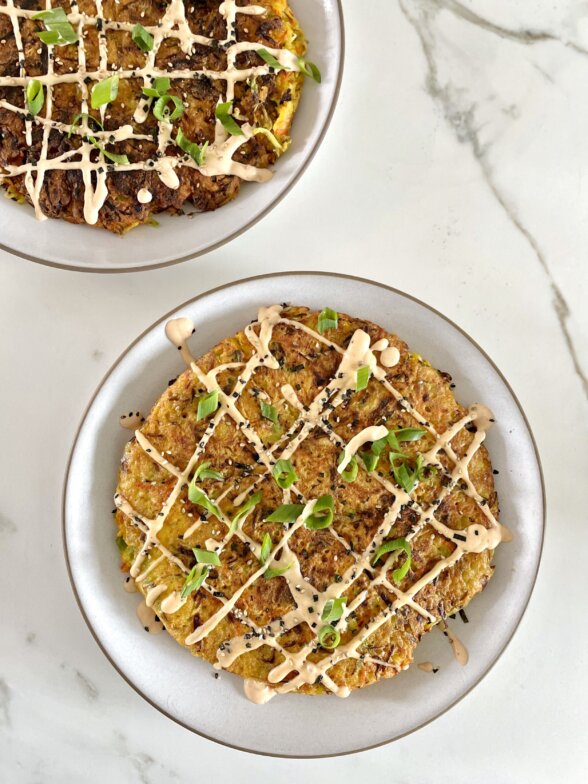
If you’ve never tried Okonomiyaki, a Japanese-style savory pancake, you’re in for a treat. This Vegetarian Okonomiyaki recipe is packed with flavor, uses simple ingredients, and is endlessly versatile for every dietary preference.
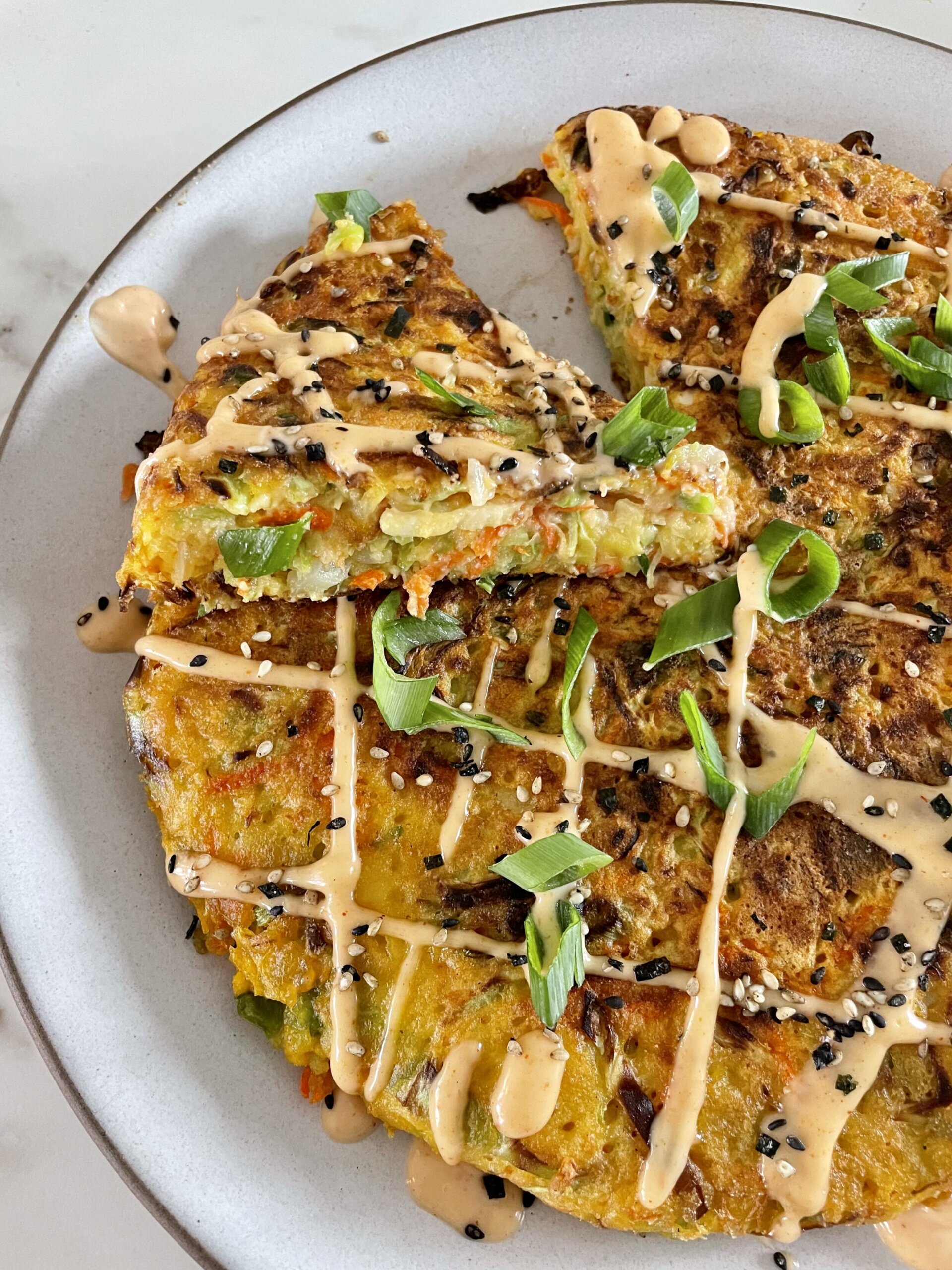
What is Okonomiyaki?
Okonomiyaki is a beloved Japanese comfort food that translates to “grilled as you like it,” reflecting its easy customization and endless variations. Traditionally enjoyed in Japanese homes and street food stalls, it’s made with simple ingredients and cooked on a griddle. My vegetarian version stays true to the spirit of this dish by keeping its rich, umami-packed flavors while making it accessible for all dietary preferences.
Why You’ll Love This Vegetarian Okonomiyaki Recipe
There will be some of you who will look past this Japanese vegetable pancake, also known as Okonomiyaki, and think it’s nothing special. You need to trust me here and make this. Not only am I obsessed with this, Hubs and my son fight over every last scrap. This is very filling as a light meal, or sometimes I’ll add a slice of smoked salmon on top for extra protein. Or try it served with miso-glazed salmon, shirataki noodles, or shrimp stir-fry.
This okonomiyaki pancake recipe is wonderfully budget-friendly, making it perfect for using up leftover ingredients and pantry staples you already have on hand. It’s also incredibly flexible—while cabbage is the star, you can easily customize it with your favorite veggies or preferred meats to suit your taste. Most importantly, it’s absolutely delicious, with a savory, satisfying texture and layers of incredible flavor that will keep you coming back for more.
Ingredients You’ll Need
Here’s what you’ll need to make this dish, along with some helpful tips for substitutions:
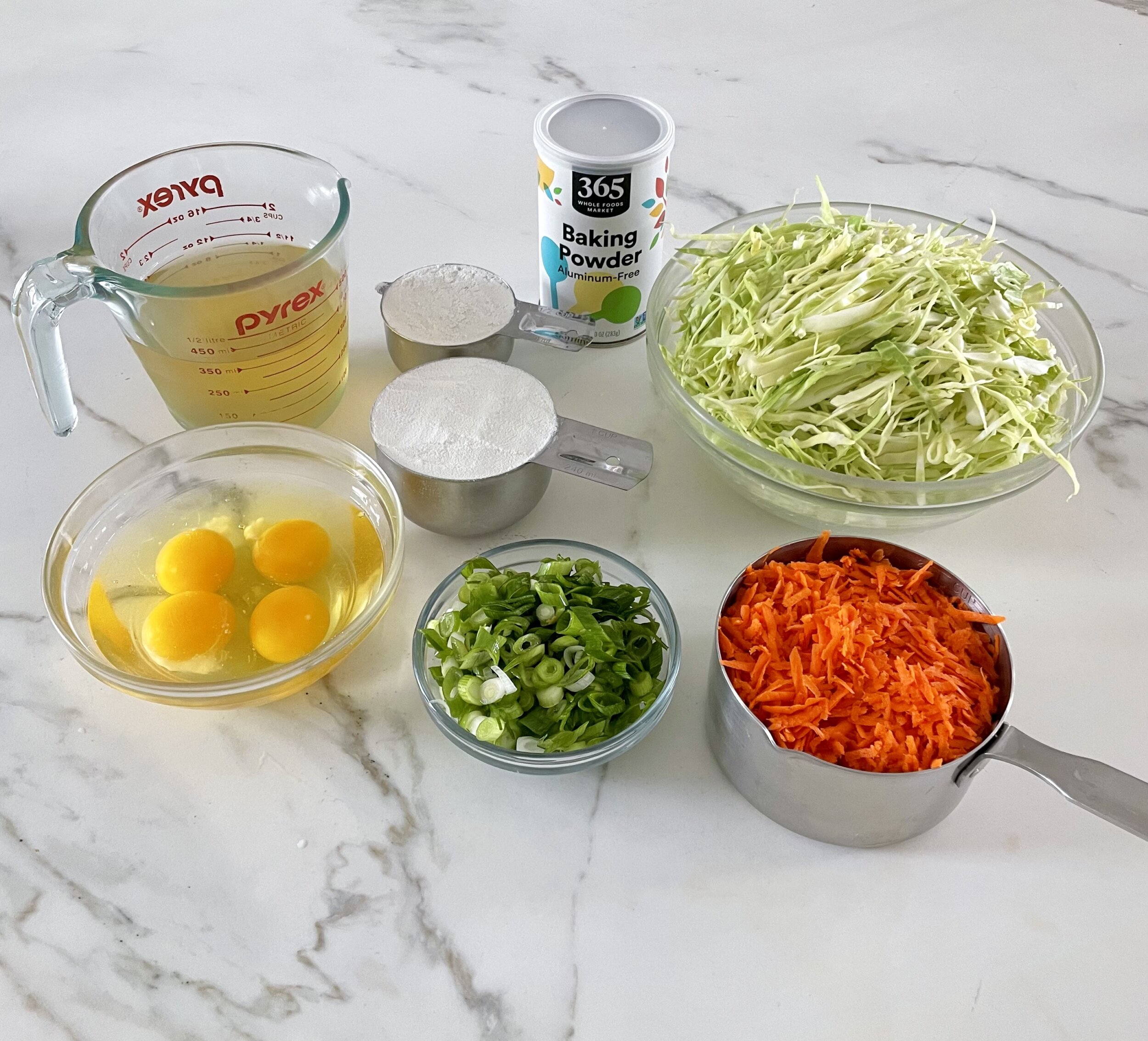
- Mayonnaise: This creamy base is essential for the signature drizzle sauce that tops the pancake. I usually go with Vegenaise for a lighter, plant-based option, but Kewpie Mayo (a Japanese mayonnaise), with its blend of vinegar and a hint of sweetness, gives a more traditional Japanese flavor.
- Sriracha: Adds heat; adjust the amount to suit your taste.
- Toasted Sesame Oil (optional): A little drizzle of this nutty oil enhances the depth of flavor in the sauce. While it’s optional, it’s a nice addition if you have it on hand.
- Rice Flour: This ingredient creates a light, airy texture in the pancake. Both brown and white rice flours work well, but you can also substitute with all-purpose flour or a gluten-free blend if needed.
- Baking Powder: I prefer aluminum-free.
- Dashi: A smoky, umami-rich broth made from bonito flakes and seaweed. Substitute with chicken, vegetable stock, or plant-based milk.
- Eggs: These help bind the batter together and give the pancake structure. For an egg-free version, see the substitutions below.
- Cabbage: The star of the dish, cabbage adds crunch and body to the pancake. Napa, Savoy, or standard green cabbage all work well, and for convenience, a pre-shredded slaw mix can save time.
- Carrots: Add sweetness and color.
- Scallions: Use both the green and white parts for maximum flavor.
For exact recipe ingredients, see the full printable recipe card below.
How to Make Vegetarian Okonomiyaki
Step1. Prepare the sauce: In a small bowl, mix mayonnaise, Sriracha, and toasted sesame oil. Set aside.
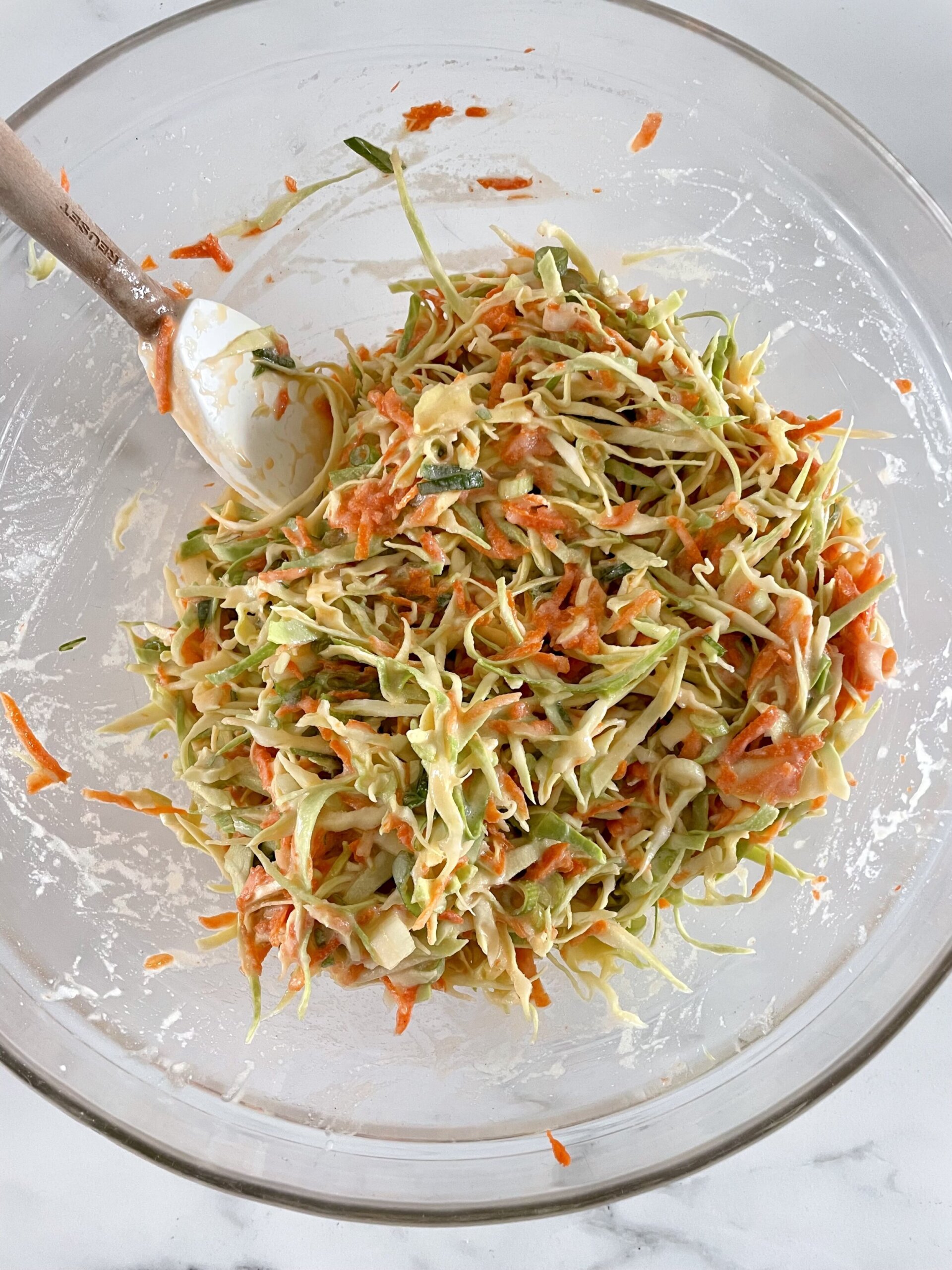
Step 2. Make the batter: In a large mixing bowl, whisk together rice flour, baking powder, and salt. Add dashi and eggs, whisking until smooth. Toss in the shredded cabbage, carrots, and scallions, ensuring they’re fully coated.
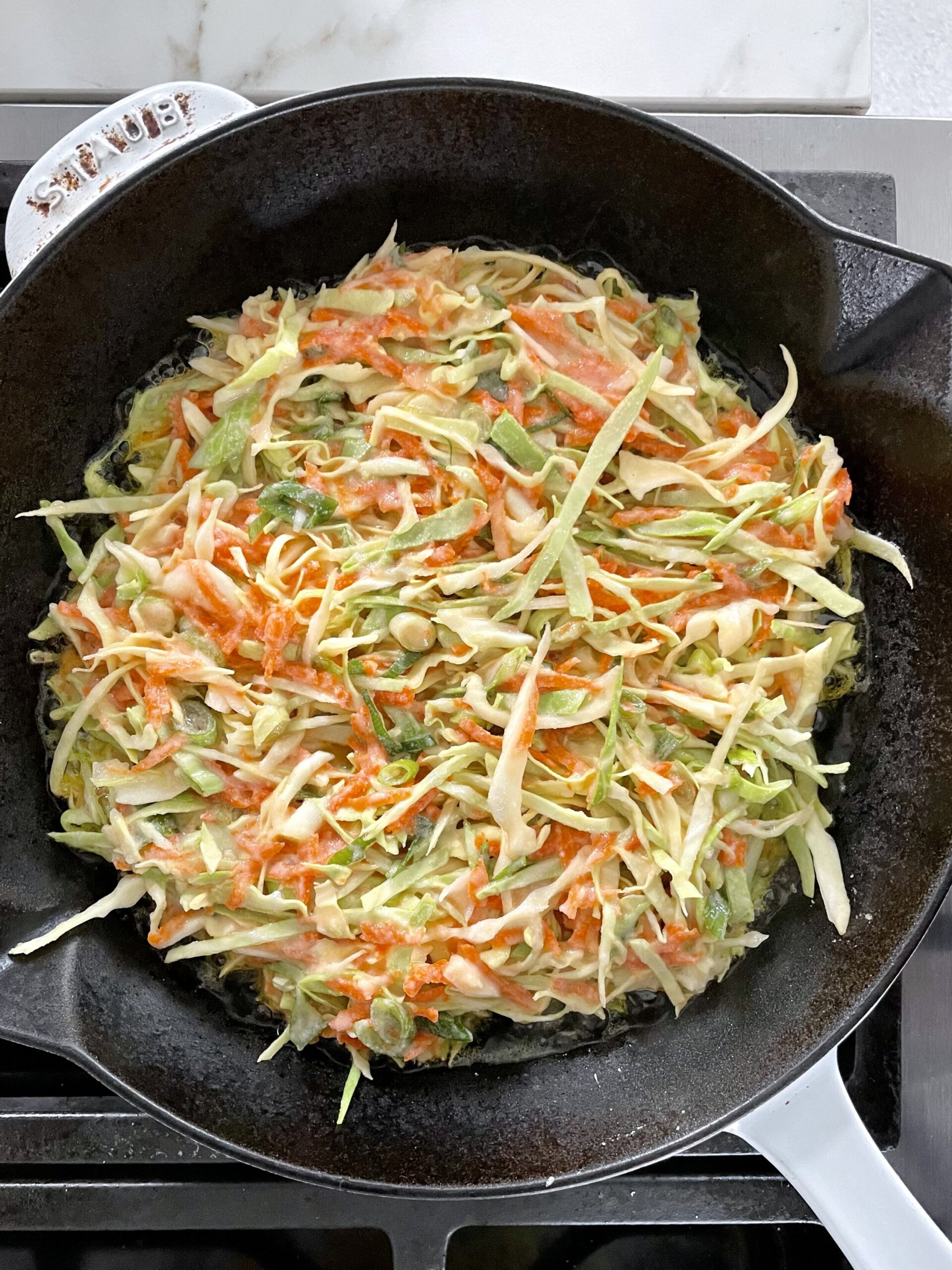
Step 3. Pan fry the pancakes: Heat a nonstick or cast iron skillet over medium heat. Add enough avocado oil to coat the pan. Spread half the okonomiyaki batter evenly and cook until the underside is golden brown, about 5 minutes. Flip (carefully!) and cook the other side for 5 minutes. Repeat with the remaining batter.
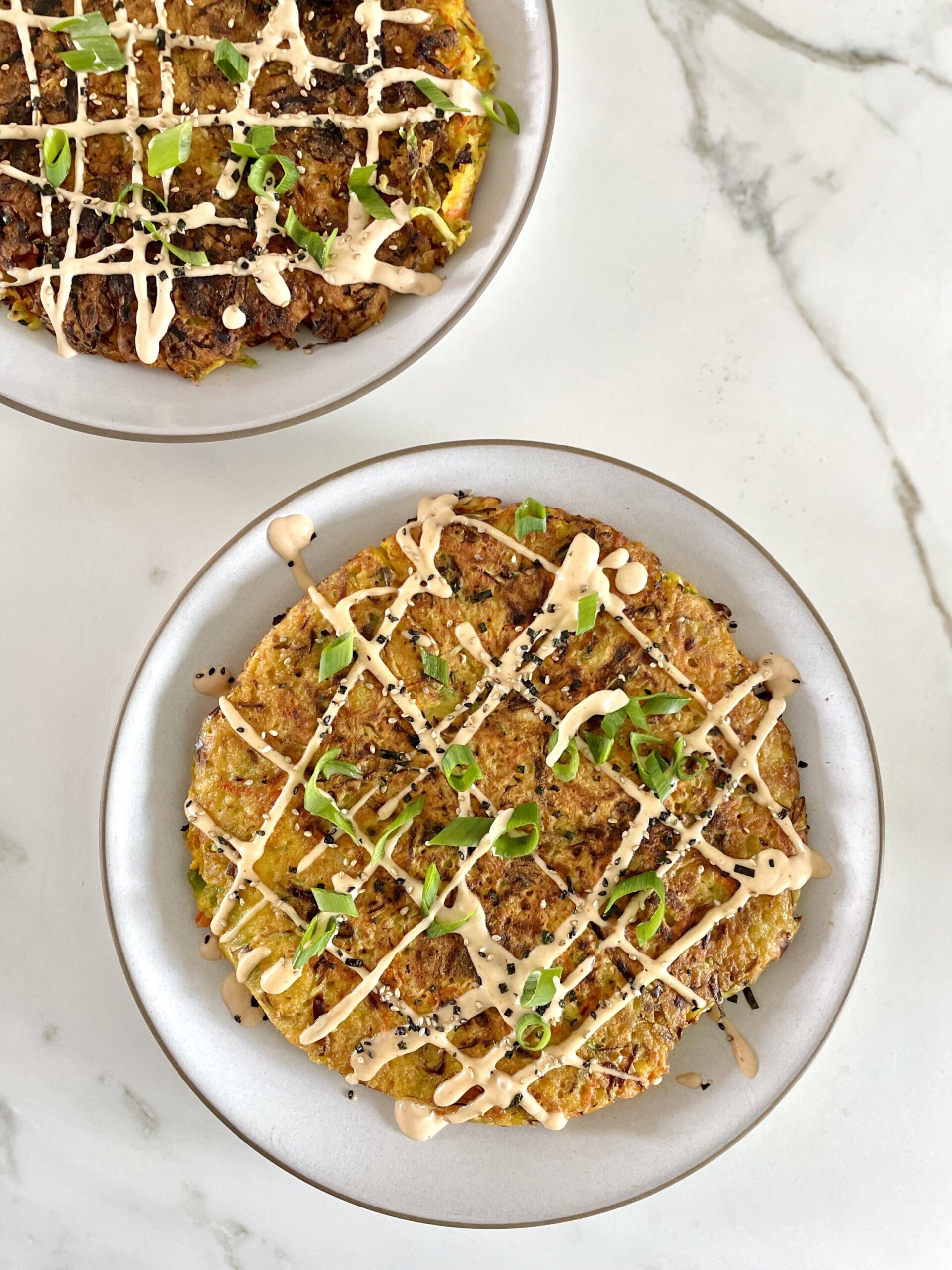
Step 4. Serve: Drizzle with the sauce, and top with your favorite garnishes like seaweed flakes or bonito flakes.
Expert Tips
- Flip with confidence: If flipping a large pancake feels daunting, try making smaller pancakes for easier handling.
- Keep them warm: Cooked pancakes can be kept warm in a 250°F oven while you finish the batch.
- Prep ahead: You can shred the vegetables and mix the batter ahead of time, but don’t combine them until just before cooking.
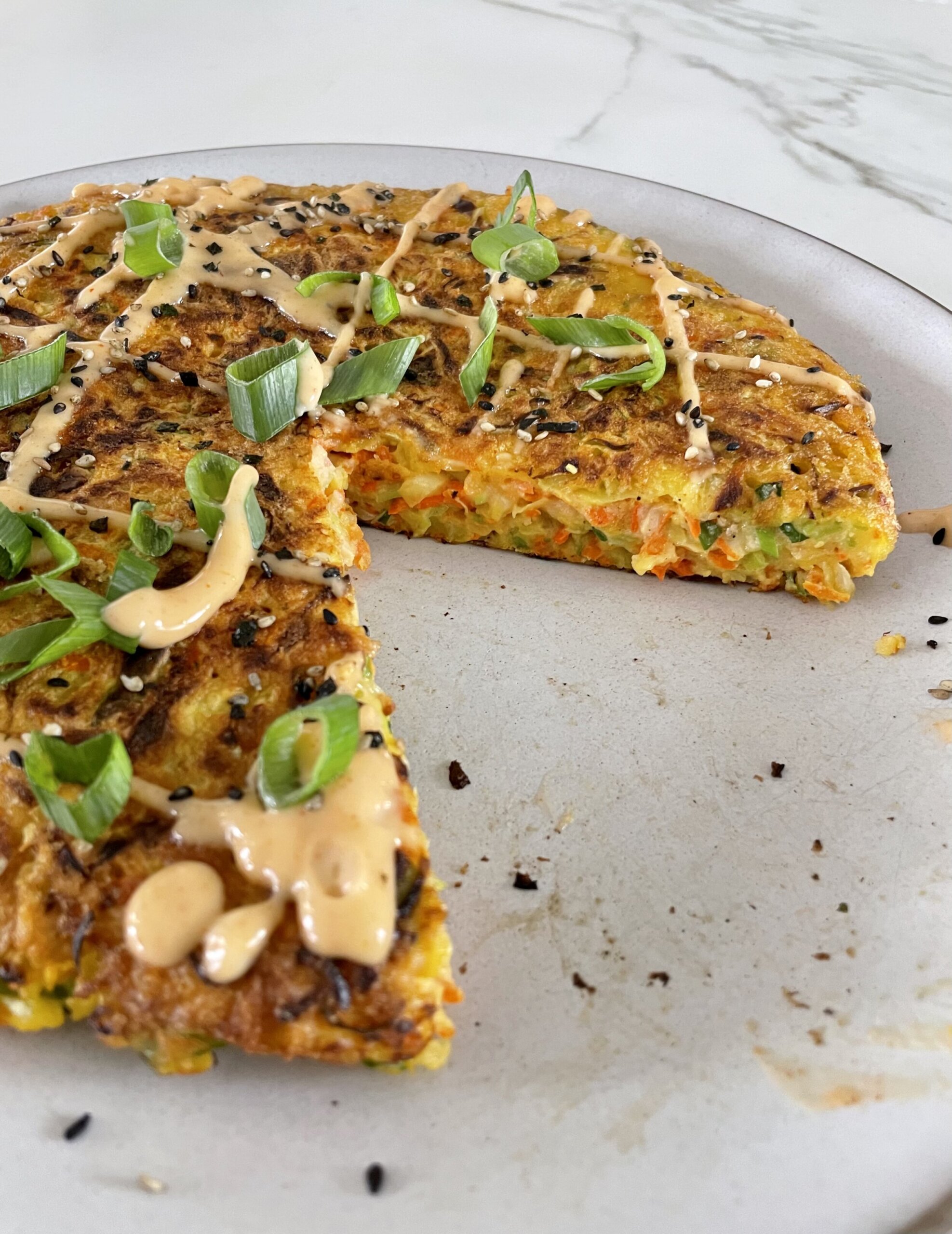
Serving Tips
Okonomiyaki translates to “grilled as you like it,” so feel free to get creative!
- In Japan, it’s traditionally topped with okonomiyaki sauce (sometimes labeled “Japanese BBQ sauce” which is like ketchup meets Worcestershire sauce), drizzles of Kewpie mayo, green onions, dried seaweed flakes, and bonito flakes.
- Additions like pork belly, shrimp, octopus, calamari, oysters, yakisoba noodles, udon noodles, shiitake mushrooms, cheese, smoked salmon, or thinly sliced kale are perfect for this dish. Avoid high-moisture vegetables like zucchini, as they can make the pancake soggy.
- Pair these pancakes with a side of miso soup or a fresh asian noodle salad for a light meal. For drinks, green tea or chilled sake would complement the savory flavors beautifully.
- For a vegan version, replace eggs with a mixture of 2 cups chickpea flour and 3 cups dashi or plant-based milk. Let it sit for a couple of hours before mixing with the veggies.
Storage Tips
- Refrigerator: Store leftover pancakes in an airtight container for up to 3 days.
- Freezer: Stack pancakes with parchment paper in between, then freeze for up to 1 month.
- Reheat: Warm in a skillet over medium heat or in the oven at 300°F until heated through.
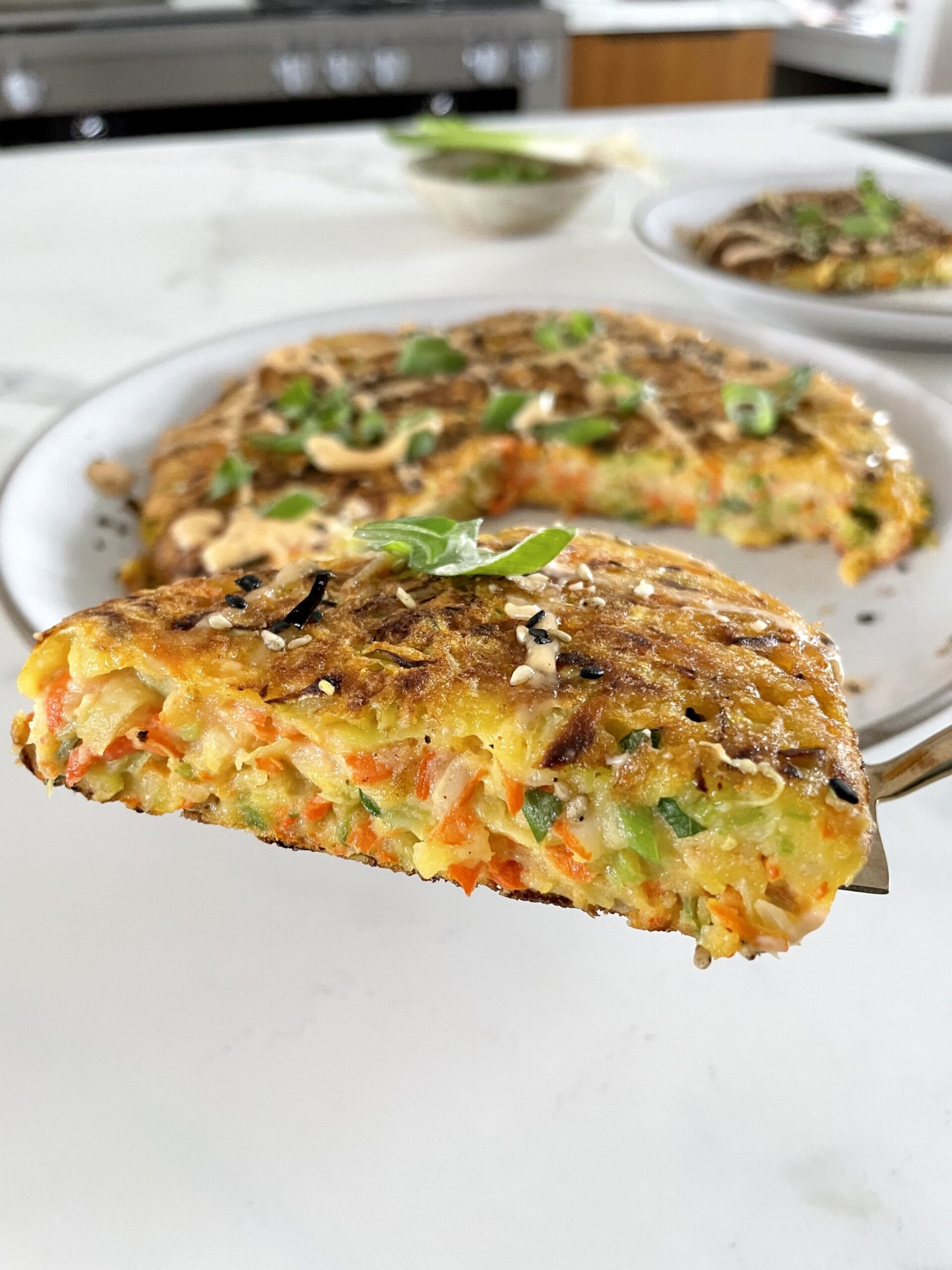
Recipe FAQs
Also called Okonomi sauce, it’s a savory, tangy sauce similar to a mix of ketchup and Worcestershire. You can find it in Asian grocery stores or make a quick version at home.
Absolutely! Use rice flour or a gluten-free flour blend instead of all-purpose flour.
A sharp knife or a mandoline will give you the best, thin shreds. Bagged slaw mix works in a pinch!
If your pancake is falling apart, it’s likely due to one of two reasons. First, the batter may be too thin, so make sure it has a thick, pancake-like consistency that can hold the vegetables together. If needed, add a little more flour to the batter to firm it up. Second, the pancake may not have cooked long enough on the first side. Be patient and allow the bottom to develop a golden-brown crust before flipping, as this helps it hold its shape.
Soggy pancakes are usually caused by using high-moisture vegetables, like zucchini or mushrooms, which release water as they cook. To avoid this, stick to drier vegetables like cabbage, carrots, and scallions.
More Asian Inspired Recipes
If you give this recipe a try, snap a pic and tag @pamelasalzman so I can see your beautiful creations. I also really appreciate readers taking the time to leave a star rating and review! I have started a weekly Monday newsletter with tips, musings, new recipes not published here, fun new finds, and more. Subscribe for free here.
For more delicious recipes and to learn how to be a better cook, check out my monthly online cooking classes. I have been teaching people for 15 years how to cook healthy food that their families love! Join me!
Vegetarian Okonomiyaki (Japanese Vegetable Pancake)
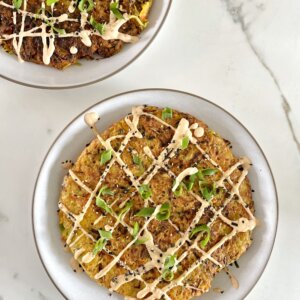
Ingredients
- Sauce, Optional, but who doesn’t love sauce?? Feel free to double or triple this
- 1/4 cup mayonnaise*
- 1 teaspoon Sriracha
- ¼ teaspoon toasted sesame oil, optional
- Pancakes
- 1 1/2 cups brown or white rice flour, my preference, GF flour blend or all-purpose flour (if you use AP flour, try to mix with a GF flour for a lighter texture)
- 1 teaspoon aluminum-free baking powder
- 1 1/4 teaspoons sea salt
- 1 ½ cups dashi, at room temp or cold (a seaweed and bonito broth | See recipe in notes). If you don’t want to use dashi you can use chicken or vegetable stock or milk/plant milk.
- 4 large eggs, lightly beaten (see notes for vegan option)
- 6 cups very thinly sliced Napa or Savoy cabbage, or standard green cabbage OR just use a bag of “slaw mix” from the supermarket
- 4 medium carrots, finely shredded, about a scant 2 cups
- 4 scallions, thinly sliced on an angle
- Avocado oil for cooking
Instructions
- Mix sauce ingredients together and set aside. This will stay good in the fridge for weeks.
- In a large mixing bowl whisk together the flour, baking powder, and salt. Add the dashi (or milk) and eggs. Whisk ingredients together to make a smooth batter. Stir in the vegetables and toss to coat completely in the batter.
- Preheat a 10 to 11-inch nonstick or well-seasoned cast iron skillet over medium heat. Add enough avocado oil to coat the bottom and wait for it to shimmer. Add half the batter and spread out over the skillet. Allow the pancake to cook until the underside is golden and cooked, about 5 minutes. The top will still be raw. Either flip the pancake (takes some practice) or slide onto a plate and invert the skillet onto the plate and flip. Use pot holders please!
- Cook until the underside is golden, about 5 more minutes. You can also make lots of small pancakes. Serve with desired accompaniments. You can keep them warm on a baking sheet in the oven at 250 degrees until needed, but these are best eaten right after you make them. You can shred the vegetables in advance and make the batter in advance, but don’t combine the veggies and the batter until just before cooking.
Notes
- Flip with confidence: If flipping a large pancake feels daunting, try making smaller pancakes for easier handling.
- Keep them warm: Cooked pancakes can be kept warm in a 250°F oven while you finish the batch.
- Prep ahead: You can shred the vegetables and mix the batter ahead of time, but don’t combine them until just before cooking.
- Refrigerator: Store leftover pancakes in an airtight container for up to 3 days.
- Freezer: Stack pancakes with parchment paper in between, then freeze for up to 1 month.
- Reheat: Warm in a skillet over medium heat or in the oven at 300°F until heated through.
 Like this recipe? Rate & comment below!
Like this recipe? Rate & comment below!


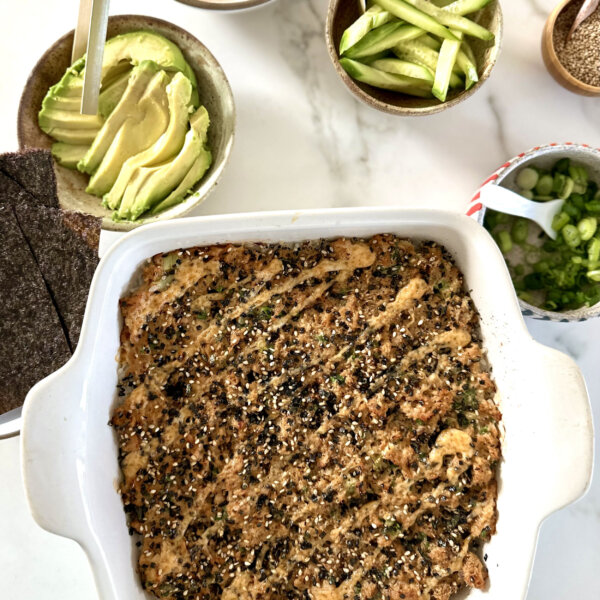
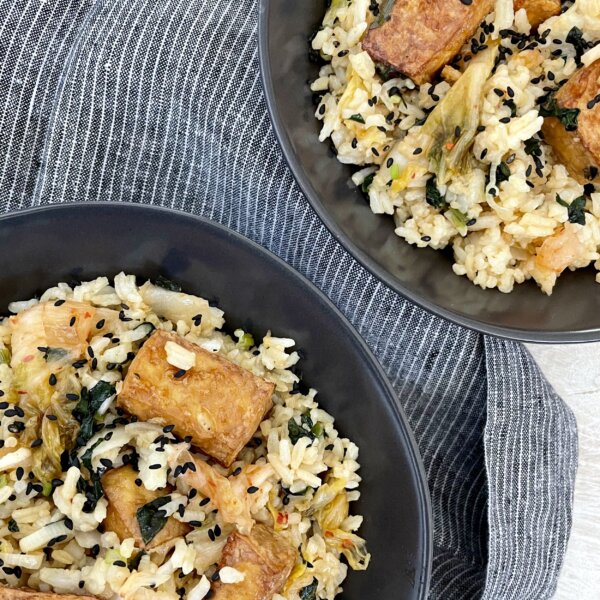
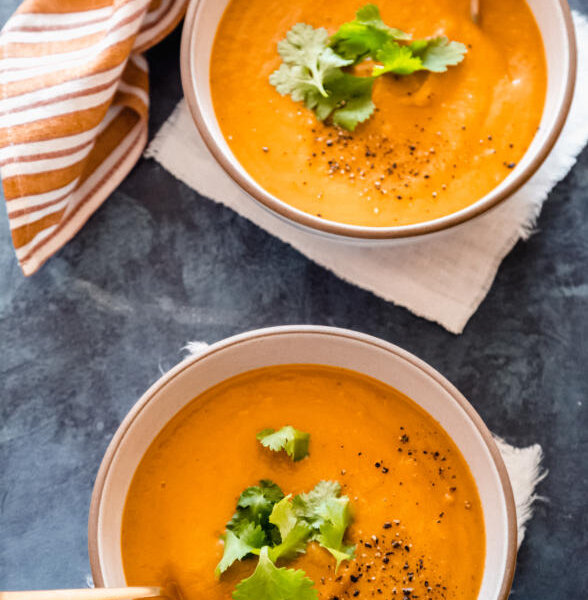

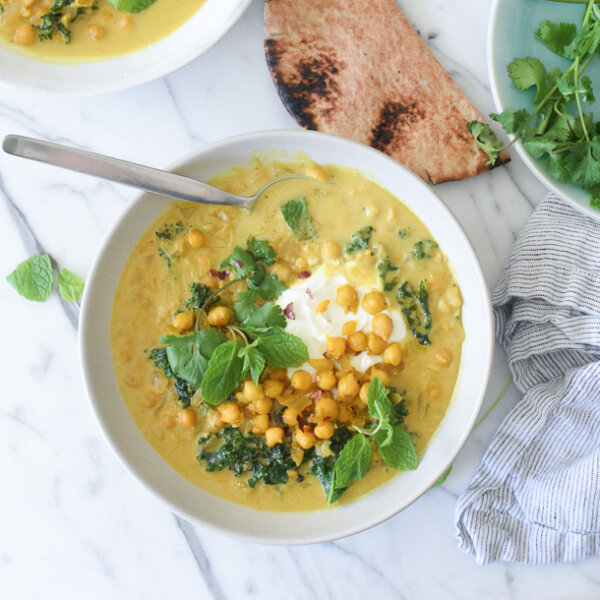
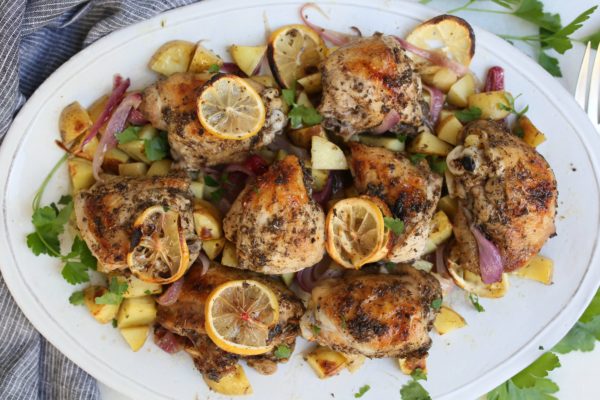
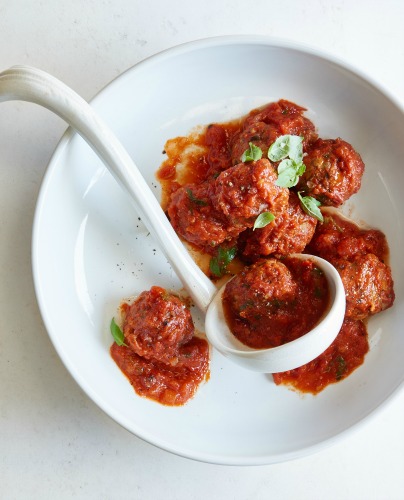






We love this recipe.
I’m so happy to hear that!
What do you do with the left-over kombu and bonito flakes from making the dashi? It seems a waste to just toss them. What about incorporating part of it into the veg mix for the pancakes?
You extract most of the flavor after you steep them for the dashi. I have tried eating kombu after making broth, and honestly, I personally didn’t love it. That said, if you wanted to try to stir them into the pancake, I don’t see why you couldn’t! Lots of iodine and minerals in the kombu!
This looks delish. I have dashi miso in the frig. Could I mix that with the stock to get the same result? If so, how much would you suggest? Thanks:)
I don’t see why not. I haven’t tasted dashi miso, but the flavor from the distinctive flavor from homemade dashi is from the bonito flakes which are smoked. I would try 1 Tbs miso for 1 cup of water. Let me know how it turns out!
Looks yummy! Hope purple cabbage works too as I have most of a head to use up.
Sure! It will tint the interior of the pancake a little lavender, but that’s no big deal. I’m sure it will be just as delicious.